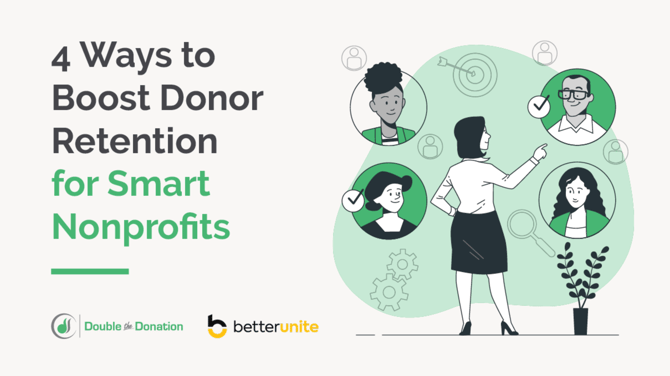4 Ways to Boost Donor Retention for Smart Nonprofits

4 Ways to Boost Donor Retention for Smart Nonprofits
A significant component of any carefully crafted fundraising plan is donor retention. While acquiring new supporters is a must, it’s important to recognize the value of a steady, well-retained donor base. After all, this is the key to sustainable revenue generation—and keeping your nonprofit mission funded year after year.
In this guide, we’ll walk through four tried-and-true strategies for nonprofits like yours looking to elevate their long-term retention. These include the following practices:
- Enlist personalization and segmentation in donor outreach.
- Promote and encourage workplace giving.
- Focus on impact.
- Make giving easy.
Ready to drive sky-high retention rates for your organization? Let’s begin.
1. Enlist personalization and segmentation in donor outreach.
Donors want to feel a sense of individual importance with your organization and its mission—and they want their communications with your team to reflect that. When they do, they’re more likely to stay involved with your nonprofit over time.
Thus, implementing personalization and segmentation in donor messaging can have a significant positive effect on your retention rates. When you tailor communications (from content to delivery channel and more) to each individual, you can craft donor messaging that deepens relationships and produces successful fundraising results.
And the more you know about your supporters, the better your team will be able to tailor outreach accordingly. Luckily, a donor screening tool can provide users with the following insights about their supporters:
- Age, gender, education, and other personal demographics
- Wealth ratings, estimated giving capacities, and suggested ask amounts
- Employment information, including company and role
- Household details and relationships
- Responsiveness by marketing channel
- Interests, values, hobbies, and more
These data points, in addition to supporters’ names and engagement history tracked in your donor management system, can provide a solid foundation of information with which to customize your communications.
2. Promote and encourage workplace giving.
One of our favorite ways to drive retention is by diversifying the ways in which supporters can get involved in your cause. Remember: not everything has to be a monetary donation to benefit your mission. Switching up your asks can help deepen supporter relationships beyond what may otherwise risk feeling transactional.
Specifically, we recommend highlighting workplace giving programs as a key way for donors and volunteers to amplify their support of your organization without reaching back into their own wallets to do so.
Double the Donation research estimates that over 26 million individuals work for companies with matching gift programs alone. When your donors fall into this group, you have the opportunity to encourage them to stretch their personal donations further with a corporate match. Similarly, those who donate their time and skills—and work for companies that provide volunteer grants—can turn their hours of support into financial gain for your nonprofit.
Not to mention, the same reports indicate that nonprofit supporters are more likely to get involved when they know a workplace giving program is available. In fact, 84% of survey participants say they’re more likely to donate if a match is offered, while 1 in 3 would give more should a match be applied.
However, without a dedicated approach from fundraising organizations like yours, the majority of donors who qualify for these programs remain unaware of their existence. That’s why taking proactive measures to incorporate matching gift and volunteer grant opportunities in your donor communications can go a long way.
3. Focus on impact.
Knowing their donations are making a difference is one of the greatest motivators behind charitable giving. When you prioritize transparent, impact-focused fundraising initiatives, you can build trust with your supporters, which ultimately translates to heightened retention.
Be sure to communicate the specific ways in which your nonprofit donations are benefitting your community. Doing so in the most tangible, mission-focused terms is likely to resonate with your supporters!
Here’s an example:
“Your generosity is shaping futures! Meet Maria, a determined young scholar from an underserved community. Through your donations, we provided Maria with essential learning resources, mentorship, and scholarships. We're thrilled to share that Maria recently graduated as valedictorian, earning a full scholarship to a prestigious university.”
Donors who understand how their contributions directly lead to positive outcomes feel a deeper sense of fulfillment in giving. Regularly sharing case studies, personal impact stories, project updates, visual aids, and more can all go to verify funding effectiveness.
4. Make giving easy.
Roadblocks within the donation experience can greatly hinder a supporter’s likelihood of making a repeat gift—regardless of how engaged they’ve stayed with your mission and ongoing efforts. Thus, streamlining giving with a user-friendly platform is a must for maximizing retention.
This might mean:
- Offering automatically recurring donation opportunities
- Promoting multiple ways to give (i.e., online donations, direct mail, mobile giving, event pledges, and more)
- Accepting multiple forms of payment online (i.e., credit/debit, electronic check, mobile payment)
By reducing friction, you can ensure more donors complete their gifts and encourage them to continue supporting your organization time and time again.
Strengthening donor relationships is essential if you want to retain their support from one gift to the next. Doing so deepens their sense of connection, commitment, and community with your cause.
Remember: the power of tailored messaging, unique engagement opportunities, impact-driven communications, and a simplified giving process cannot be overstated.
If your team is ready to implement the practices explored above, one of the best places to start is with your donor data. This goldmine of insights allows you to uncover trends, patterns, preferences, and more that can then guide and inform your donor-centric strategies that keep supporters with you for the long run.
Thank you for reading! Let's go do some good.
-1.png?width=240&height=100&name=Heading%20(2)-1.png)